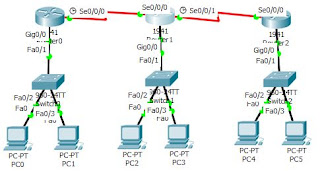Configuration of Default Routing |In this article we learn about the concept of default routing and how to configure default routing and after configuration we will see how to verify default routing.
What is Default routing
It is one type of static routing. Default routing is the routing method when packets are send to the destination which is not listed in the routing tables. Basically default routing is in the stub network.
Stub network is the network which has one exit point, that means all routers in the network are configured to send the packet to a single router which is the gateway of this network.
Lab Diagram
 |
| Default Routing lab using packet tracer |
In the above diagram we will be configure the default routing using three routers.
Configuration of Default Routing
First we configure on router0.
Router#conf t
Enter configuration commands, one per line. End with CNTL/Z.
Router(config)#int gigabitEthernet 0/0
Router(config-if)#ip address 10.0.0.1 255.0.0.0
Router(config-if)#no shut
Router(config)#int serial 0/0/0
Router(config-if)#clock rate 64000
Router(config-if)#ip address 20.0.0.1 255.0.0.0
Router(config-if)#no shut
To configure static route on router0 we should execute the below command.
Router(config)#ip route 0.0.0.0 0.0.0.0 20.0.0.2
Router(config)#ip route 0.0.0.0 0.0.0.0 20.0.0.2
Router(config)#ip route 0.0.0.0 0.0.0.0 20.0.0.2
Then we configure on router1.
Router#conf t
Enter configuration commands, one per line. End with CNTL/Z.
Router(config)#int gigabitEthernet 0/0
Router(config-if)#ip address 30.0.0.1 255.0.0.0
Router(config-if)#no shu
Router(config)#int serial 0/0/0
Router(config-if)#ip address 20.0.0.2 255.0.0.0
Router(config-if)#no shut
Router(config)#int serial 0/0/1
Router(config-if)#ip address 40.0.0.1 255.0.0.0
Router(config-if)#no shut
To configure static route on router1 we should execute the below command.
Router(config)#ip route 0.0.0.0 0.0.0.0 20.0.0.1
Router(config)#ip route 0.0.0.0 0.0.0.0 40.0.0.2
Then we configure on router2.
Router#conf t
Enter configuration commands, one per line. End with CNTL/Z.
Router(config)#int gigabitEthernet 0/0
Router(config-if)#ip address 50.0.0.1 255.0.0.0
Router(config-if)#no shut
Router(config)#int serial 0/0/0
Router(config-if)#clock rate 64000
Router(config-if)#ip address 40.0.0.2 255.0.0.0
Router(config-if)#no shut
To configure static route on router2 we should execute the below command.
Router(config)#ip route 0.0.0.0 0.0.0.0 40.0.0.1
Router(config)#ip route 0.0.0.0 0.0.0.0 40.0.0.1
Router(config)#ip route 0.0.0.0 0.0.0.0 40.0.0.1
Verify default route
To verify the default route we execute the below command on router0
Router#sh ip route
Codes: L - local, C - connected, S - static, R - RIP, M - mobile, B - BGP
D - EIGRP, EX - EIGRP external, O - OSPF, IA - OSPF inter area
N1 - OSPF NSSA external type 1, N2 - OSPF NSSA external type 2
E1 - OSPF external type 1, E2 - OSPF external type 2, E - EGP
i - IS-IS, L1 - IS-IS level-1, L2 - IS-IS level-2, ia - IS-IS inter area
* - candidate default, U - per-user static route, o - ODR
P - periodic downloaded static route
Gateway of last resort is 20.0.0.2 to network 0.0.0.0
10.0.0.0/8 is variably subnetted, 2 subnets, 2 masks
C 10.0.0.0/8 is directly connected, GigabitEthernet0/0
L 10.0.0.1/32 is directly connected, GigabitEthernet0/0
20.0.0.0/8 is variably subnetted, 2 subnets, 2 masks
C 20.0.0.0/8 is directly connected, Serial0/0/0
L 20.0.0.1/32 is directly connected, Serial0/0/0
S* 0.0.0.0/0 [1/0] via 20.0.0.2
To verify the default route we execute the below command on router1
Router#sh ip route
Codes: L - local, C - connected, S - static, R - RIP, M - mobile, B - BGP
D - EIGRP, EX - EIGRP external, O - OSPF, IA - OSPF inter area
N1 - OSPF NSSA external type 1, N2 - OSPF NSSA external type 2
E1 - OSPF external type 1, E2 - OSPF external type 2, E - EGP
i - IS-IS, L1 - IS-IS level-1, L2 - IS-IS level-2, ia - IS-IS inter area
* - candidate default, U - per-user static route, o - ODR
P - periodic downloaded static route
Gateway of last resort is 20.0.0.1 to network 0.0.0.0
20.0.0.0/8 is variably subnetted, 2 subnets, 2 masks
C 20.0.0.0/8 is directly connected, Serial0/0/0
L 20.0.0.2/32 is directly connected, Serial0/0/0
30.0.0.0/8 is variably subnetted, 2 subnets, 2 masks
C 30.0.0.0/8 is directly connected, GigabitEthernet0/0
L 30.0.0.1/32 is directly connected, GigabitEthernet0/0
40.0.0.0/8 is variably subnetted, 2 subnets, 2 masks
C 40.0.0.0/8 is directly connected, Serial0/0/1
L 40.0.0.1/32 is directly connected, Serial0/0/1
S* 0.0.0.0/0 [1/0] via 20.0.0.1
[1/0] via 40.0.0.2
To verify the default route we execute the below command on router2
Router#sh ip route
Codes: L - local, C - connected, S - static, R - RIP, M - mobile, B - BGP
D - EIGRP, EX - EIGRP external, O - OSPF, IA - OSPF inter area
N1 - OSPF NSSA external type 1, N2 - OSPF NSSA external type 2
E1 - OSPF external type 1, E2 - OSPF external type 2, E - EGP
i - IS-IS, L1 - IS-IS level-1, L2 - IS-IS level-2, ia - IS-IS inter area
* - candidate default, U - per-user static route, o - ODR
P - periodic downloaded static route
Gateway of last resort is 40.0.0.1 to network 0.0.0.0
40.0.0.0/8 is variably subnetted, 2 subnets, 2 masks
C 40.0.0.0/8 is directly connected, Serial0/0/0
L 40.0.0.2/32 is directly connected, Serial0/0/0
50.0.0.0/8 is variably subnetted, 2 subnets, 2 masks
C 50.0.0.0/8 is directly connected, GigabitEthernet0/0
L 50.0.0.1/32 is directly connected, GigabitEthernet0/0
S* 0.0.0.0/0 [1/0] via 40.0.0.1
If this article is helpful to know Configuration of Default Routing please share this article.
If this article is helpful to know Configuration of Default Routing please share this article.

0 comments:
Post a Comment